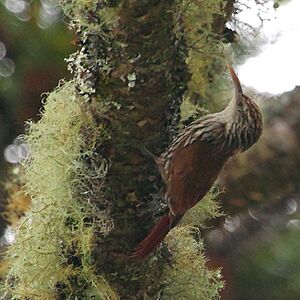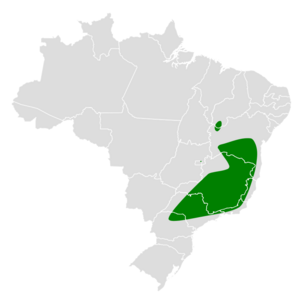Scaled woodcreeper facts for kids
Quick facts for kids Scaled woodcreeper |
|
|---|---|
 |
|
| Scaled woodcreeper L. s. squamatus at Campos do Jordão, São Paulo state, Brazil | |
| Conservation status | |
| Scientific classification | |
| Genus: |
Lepidocolaptes
|
| Species: |
squamatus
|
 |
|
The scaled woodcreeper (Lepidocolaptes squamatus) is a type of bird. It belongs to the ovenbird family called Furnariidae. This bird lives only in Brazil.
Contents
About the Scaled Woodcreeper
The scaled woodcreeper and the scalloped woodcreeper used to be thought of as the same species. Now, scientists know they are different but very closely related.
Scientists usually divide the scaled woodcreeper into two main types, called subspecies:
- L. s. squamatus (discovered by Lichtenstein in 1822)
- L. s. wagleri (discovered by Spix in 1824)
Some experts think these two types should be separate species. However, their genes are very similar. This suggests they might be better off as just one species with slight differences.
What Does the Scaled Woodcreeper Look Like?
This bird is about 19 to 20 centimeters (7.5 to 7.9 inches) long. It weighs around 27 grams (0.95 ounces). It is a medium-sized bird with a thin, slightly curved beak. Both male and female birds look the same.
Colors and Markings
Adult birds of the L. s. squamatus type have a dark face. They have whitish stripes and a broken whitish line above their eye. Their head is dark brown with light buff spots. Their back is a bright reddish-brown color. Their rump, wings, and tail are a cinnamon-red color.
Their throat is whitish. Their chest and belly are dark brown with clear, whitish stripes that have dark edges. Their eyes can be reddish-brown or brown. Their legs and feet are olive-gray to blackish. Their beak is horn-colored to pinkish, with the upper part being darker.
Differences in Subspecies
The L. s. wagleri type is a bit smaller than L. s. squamatus. Its upper body is a brighter cinnamon-red. There is less difference in color between its head and back. Its underparts are more brownish, and the dark edges on its stripes are not as clear.
Where Does the Scaled Woodcreeper Live?
The two types of scaled woodcreepers live in different parts of Brazil.
Habitat of L. s. squamatus
The L. s. squamatus type lives in eastern and southeastern Brazil. You can find it south and east of the Rio São Francisco. Its range goes from central Bahia south to northern São Paulo. This bird prefers humid Atlantic Forest. It especially likes mountain evergreen forests and lowland rainforests. It also lives in gallery forests at the western edge of its home.
Habitat of L. s. wagleri
The L. s. wagleri type lives in northeastern Brazil. It is found north of the Rio São Francisco. This includes southern Piauí, western Bahia, and northern Minas Gerais. This type lives in drier places. These include semi-deciduous and deciduous woodlands, caatinga (a type of dry forest), and gallery forests.
Both types of scaled woodcreepers live in the edges and inside of primary forests (old, untouched forests) and older secondary forests (forests that have grown back). They usually live from sea level up to about 1,600 meters (5,200 feet) high. Sometimes, they can be found as high as 2,000 meters (6,600 feet).
Behavior and Habits
Movement and Migration
The scaled woodcreeper is thought to live in the same area all year round. It does not migrate.
What Do They Eat?
We don't know all the details about what the scaled woodcreeper eats. However, it seems to mostly eat arthropods (like insects and spiders). It usually looks for food alone. Sometimes, it forages in pairs. It often joins groups of different bird species that are feeding together.
This bird hitches its way up tree trunks and along thin branches. It usually looks for food in the middle and top parts of the forest. Sometimes, it will search lower down.
Reproduction and Life Cycle
The breeding season for the scaled woodcreeper is not fully known. We know it includes October. These birds have been seen nesting in natural holes in trees. They have also nested in holes found in buildings. Not much else is known about how they raise their young.
Vocalization and Calls
The song of the L. s. squamatus type is a series of sharp, connected "pi" notes. The notes get a little higher and slower, then drop sharply at the end. Its call sounds like "péeir." The song and call of L. s. wagleri are not well known. However, they seem to be similar to those of the L. s. squamatus type.
Conservation Status
The IUCN (International Union for Conservation of Nature) says the scaled woodcreeper is of Least Concern. This means it is not currently in danger of disappearing. It lives in a large area. However, we don't know how many of these birds there are. Their numbers are thought to be going down. No immediate threats have been found.
The L. s. squamatus type is considered uncommon to fairly common in some places. The L. s. wagleri type is found in fewer specific locations. This bird needs forests that are mostly untouched. Because of this, it is very sensitive to human activities. A lot of the L. s. wagleri habitat has been lost because of deforestation. Both types of scaled woodcreepers do live in several protected areas.


